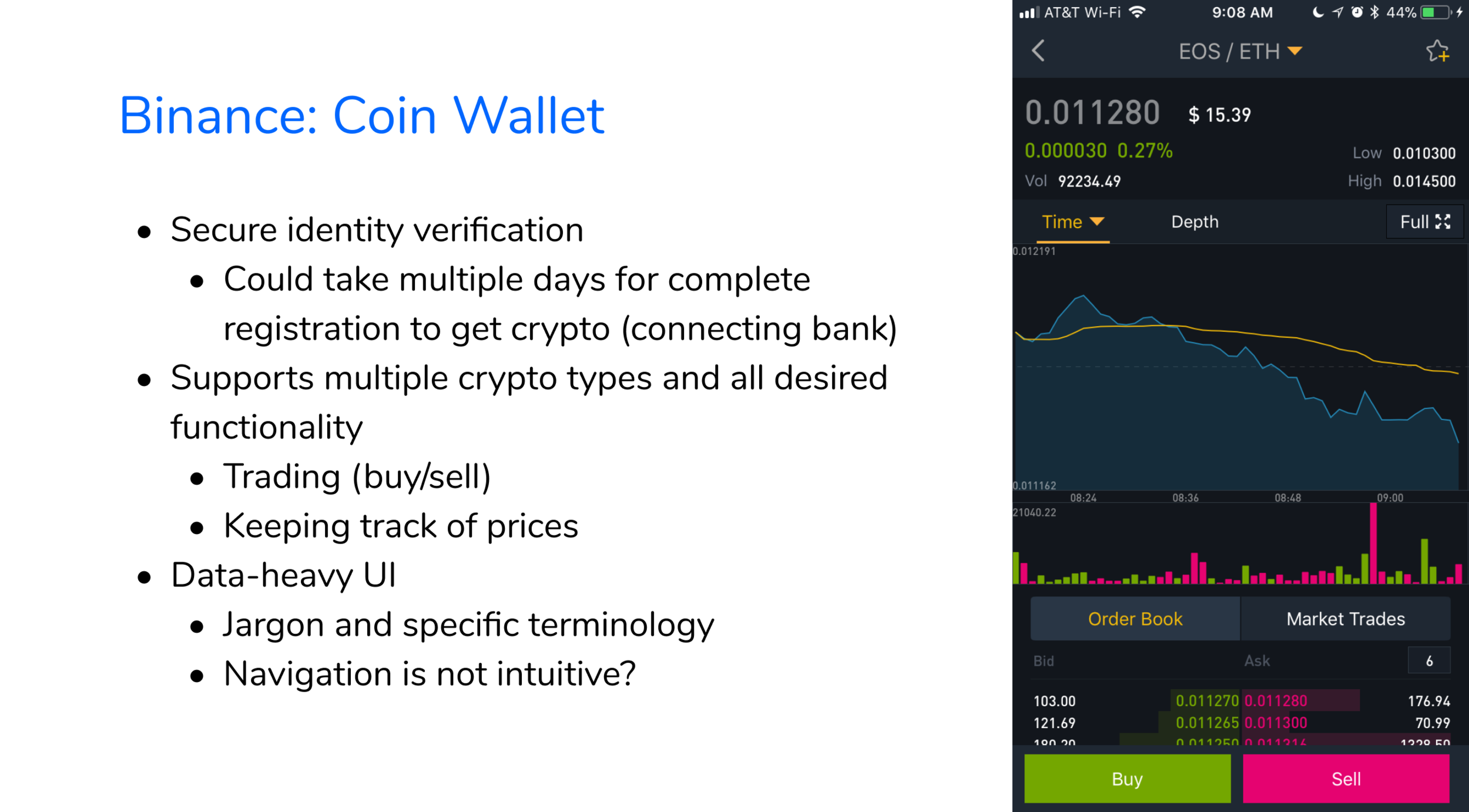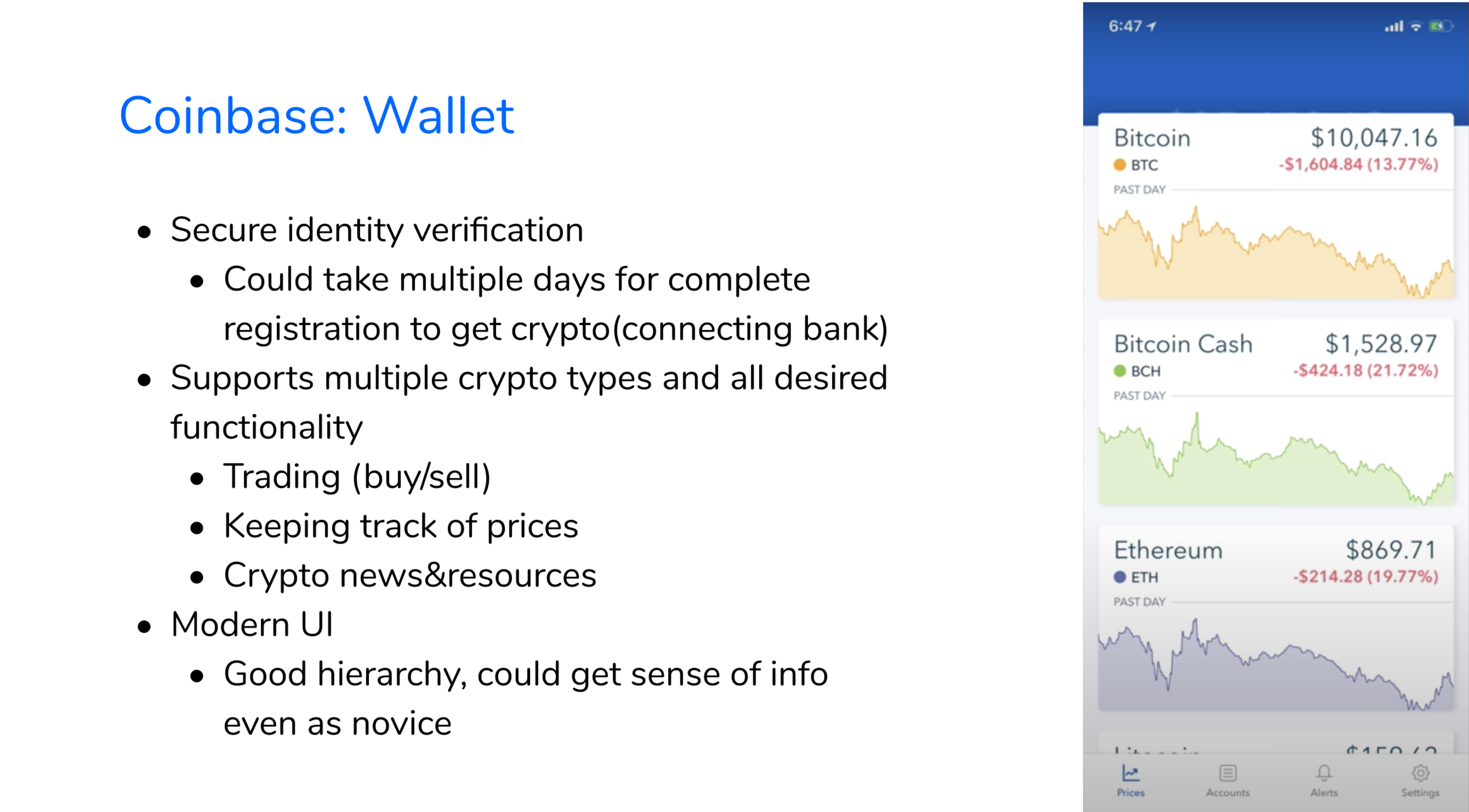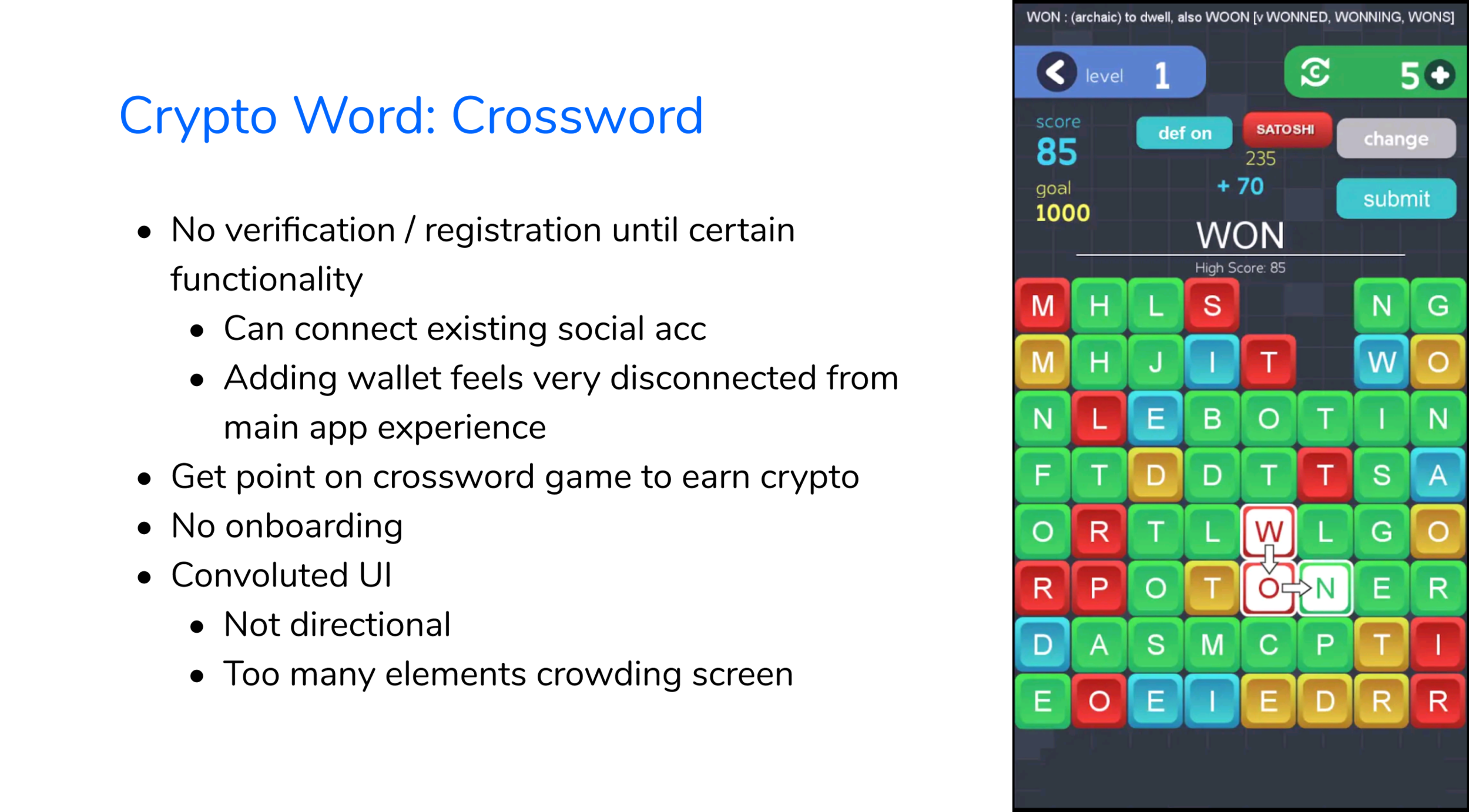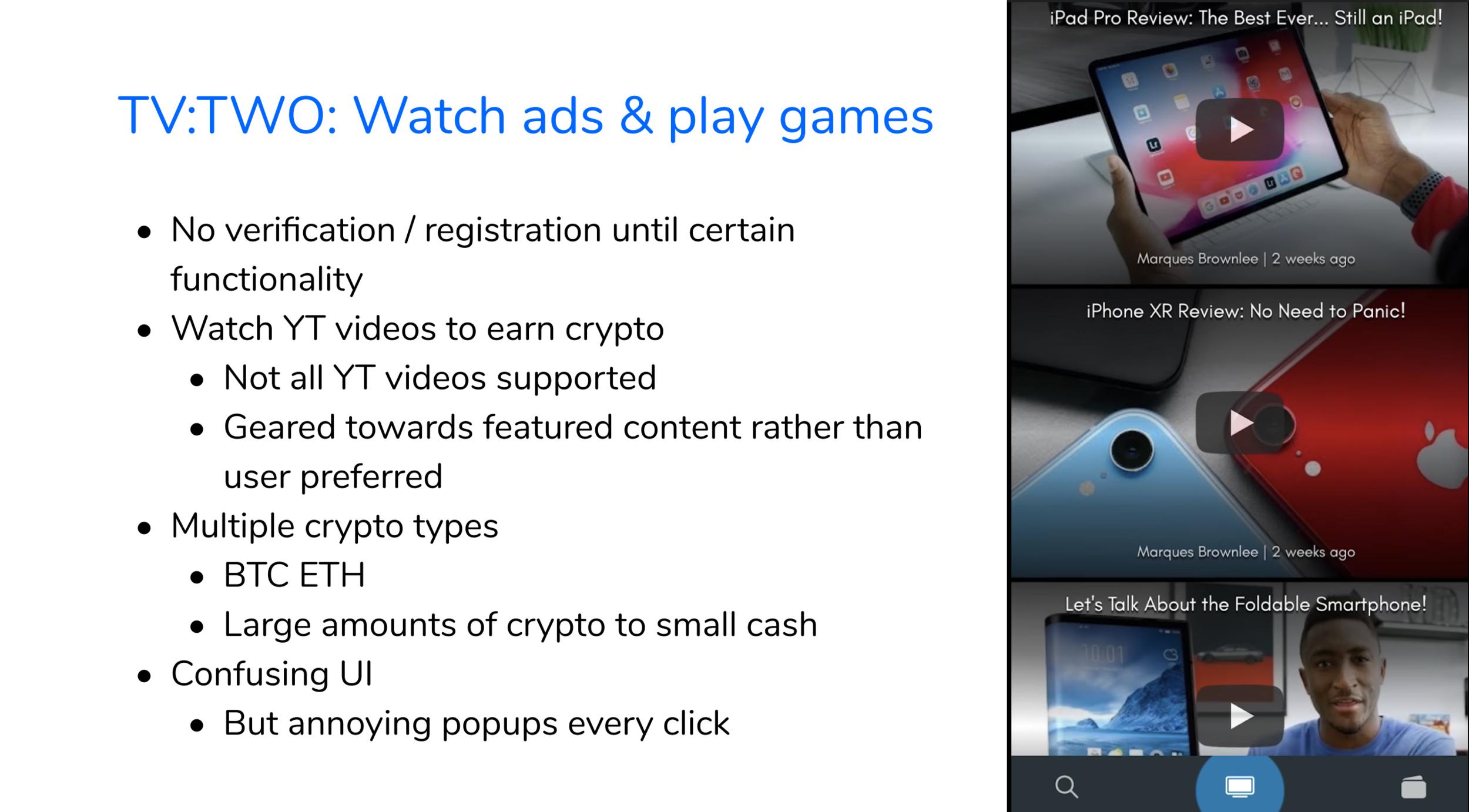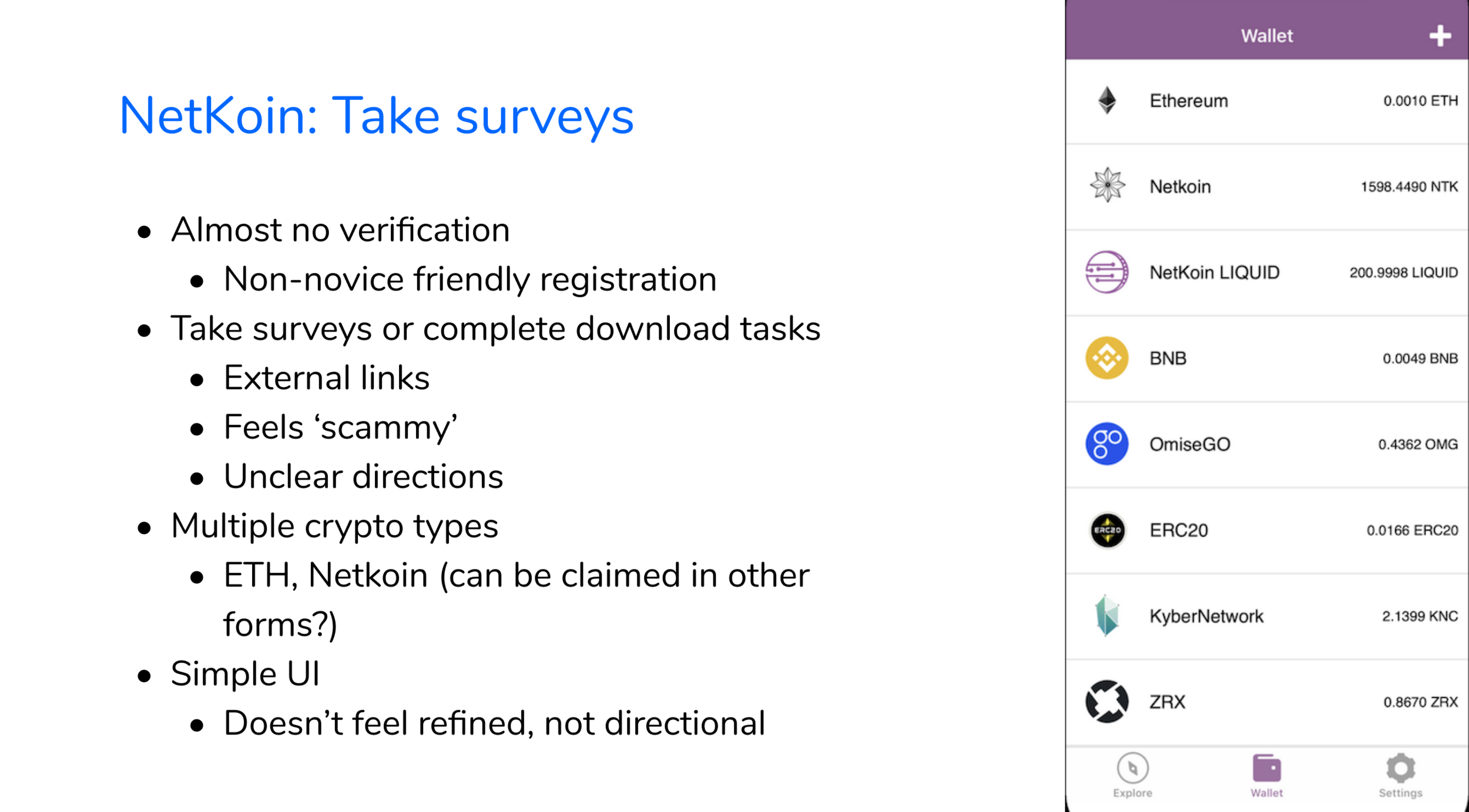Step & Spend: Kin Crypto Competition
Step & Spend is a pedometer app that helps users stay healthy while earning Kin crypto by setting daily step goals. With a team of 6 developers, a product manager, and myself, we worked together to complete the app in a short deadline. My responsibility is to lead all design work including research, strategy, UX, spec, and branding.
Kin Crypto Currency
Kin is a cryptocurrency based on monetization model that incentivizes the innovation of new use cases or values of the currency. It encourages the exchange of value between users, as opposed to harvesting user data and attention at no benefit to users themselves, creating a sense of shared economy with focus on users rather than the big-data monopolies. Using this core belief, we focused on creating a non-intrusive experience that would allow users to earn crypto while also creating connections with other users.
Understanding People’s Understanding
Initial Phase: Gathering Data
We wanted target users who had a general understanding or interest in crypto, since education of users was not our main goal. In order to gain a better insight of the audience’s mental model of crypto, we sent out a survey through different social network sites in addition to some interviews we conducted on the side with acquaintances.
Synthesis: Affinity Diagraming
After collecting the responses, we began affinity diagramming to make sense of our data. We were able to group the sticky-notes into categories of ‘Definition’, ‘Accessibility’, ‘Expertise’, and ‘Environment’.
Persona & Pain Point
From this, we identified a few personas: expert and novice. After defining the persona, we were sure we wanted to focus on the ‘Novice’ persona as our audience. We identified some common pain points experienced by people who are either very new to cryptocurrency.
Some things we noted were :
It is difficult for novices who don’t want to invest too much money or time into earning crypto to get access to small amounts of cryptocurrency they could play around with (too many steps?).
There is confusion/uneasiness in providing user data such as banking and personal information from novices who want to get on a crypto trading app.
Novices like to buy few pieces of crypto during their downtime or whenever they are reminded through things like related news articles or upon the topic being brought up by friends or family.
Already, we can see that the engagement with cryptocurrency on a daily basis is quite low for the novice user. Our focus became “How might we lower the barrier to entry for novices to have more frequent engagement with the Kin cryptocurrency?”
Competitive Analysis
Wallet Apps
Other Cryptocurrency apps “Task apps”
Explorations
At first, we gravitated towards apps like CryptoWord, where the gamification aspect of cryptocurrency made crypto seem less foreign. However, this idea was scrapped as games require dedicated time and attention, which may not appeal to novices who usually spend short amount of time on-the-go on crypto.
How could we entice and encourage users to interact with Kin on a regular basis? We put together our favorite elements from our competitive analysis along with the affinity diagram and started exploring.
Cryptocurrency Entertainment Hub
There were many apps where users simply had to watch videos or ads to earn crypto. However, this felt a little too similar to dark patterns that profit off of users by making them watch an ad for some gain within the app. We thought of ways we could utilize an existing user behavior. For example, could there be an extension user can turn on while they’re watching something on their phone to earn crypto while also benefitting their well-being? Maybe after a certain amount of screentime, the user would get bonus coins for getting off Youtube or Netflix etc…
Cryptocurrency SNS
We thought about how Crypto could be used for social networking, as people interact with it every day, effortlessly. Users can create content to post to a public board for other users can react with KIN, similar to how Reddit uses its Karma. This will be a difficult option to pursue, as it relies on having a big initial user base to create a community and users are already attached to their existing SNS sites. It would also be challenging to monitor content being produced.
Cryptocurrency Pedometer
We spent some time brainstorming about activities that are simple, daily, and does not require high effort. One of our developers had an interesting idea for a reward-based pedometer. This seemed different from the other crypto apps we’ve seen that keep users glued to the app. It encouraged healthy habits.
User Flows
I began by sketching out a brief user flow of what steps a crypto-novice would go through in order to perform the main task of the app, which is to set a goal, reach their goal, and claim their Kin.
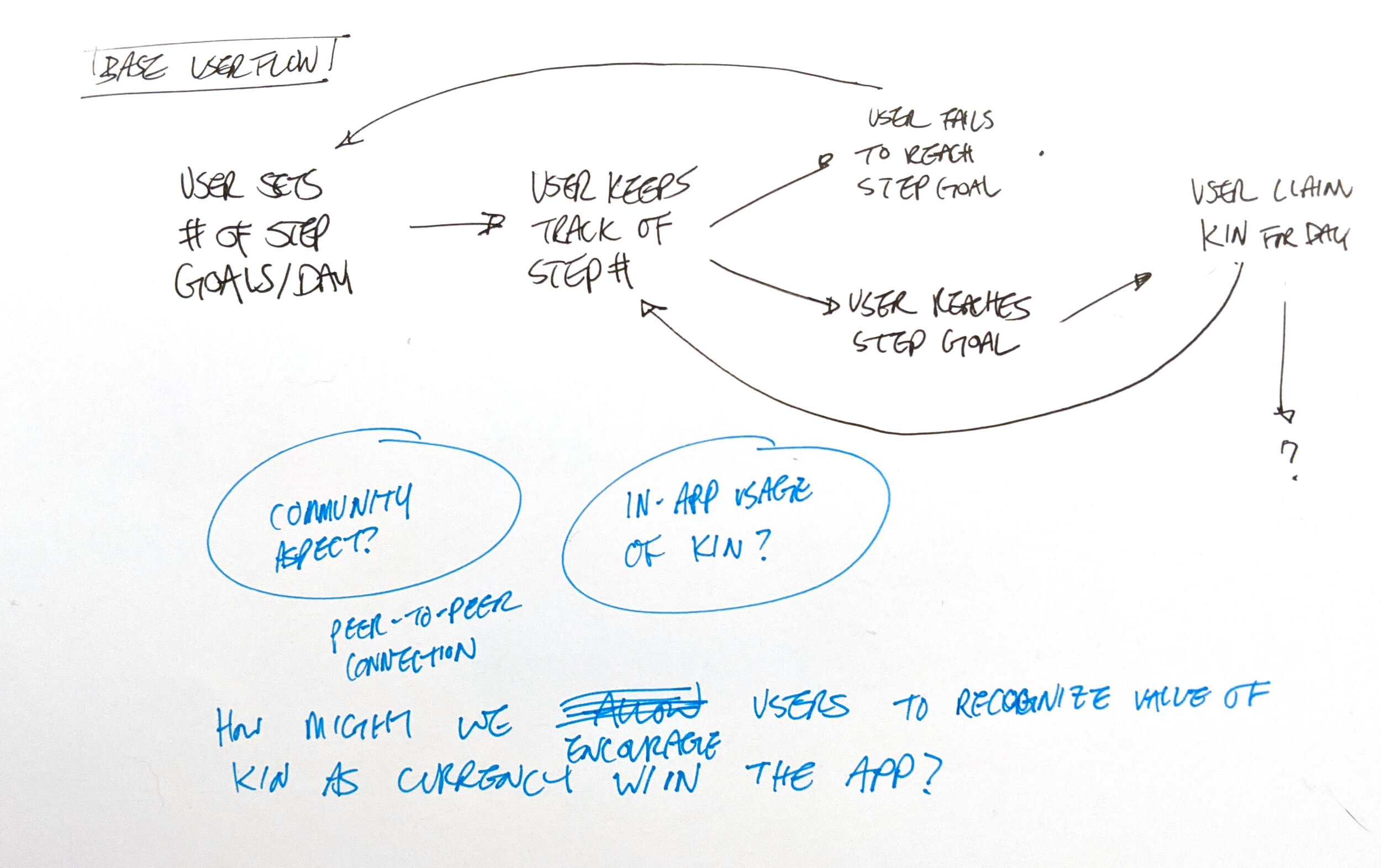
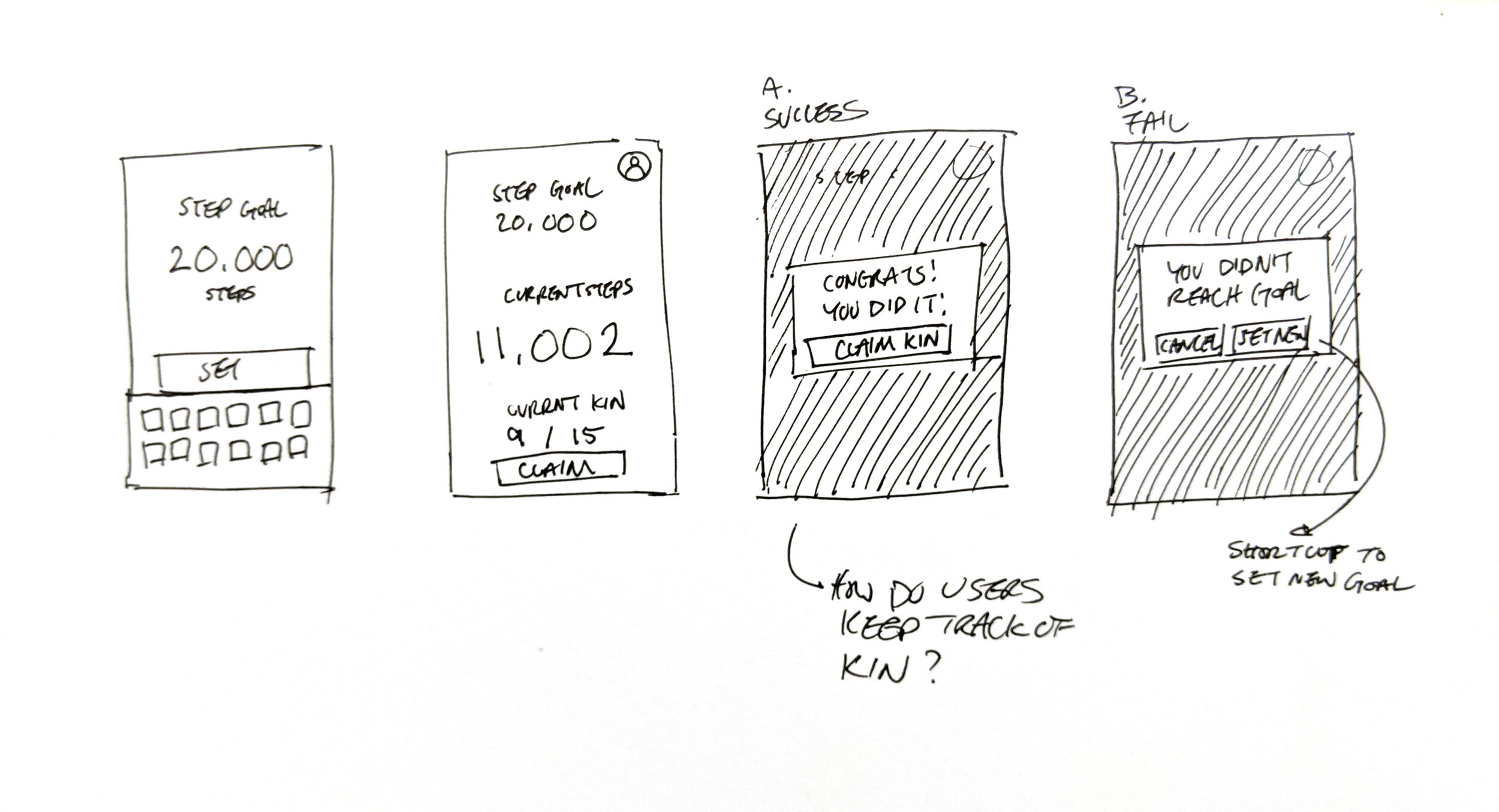
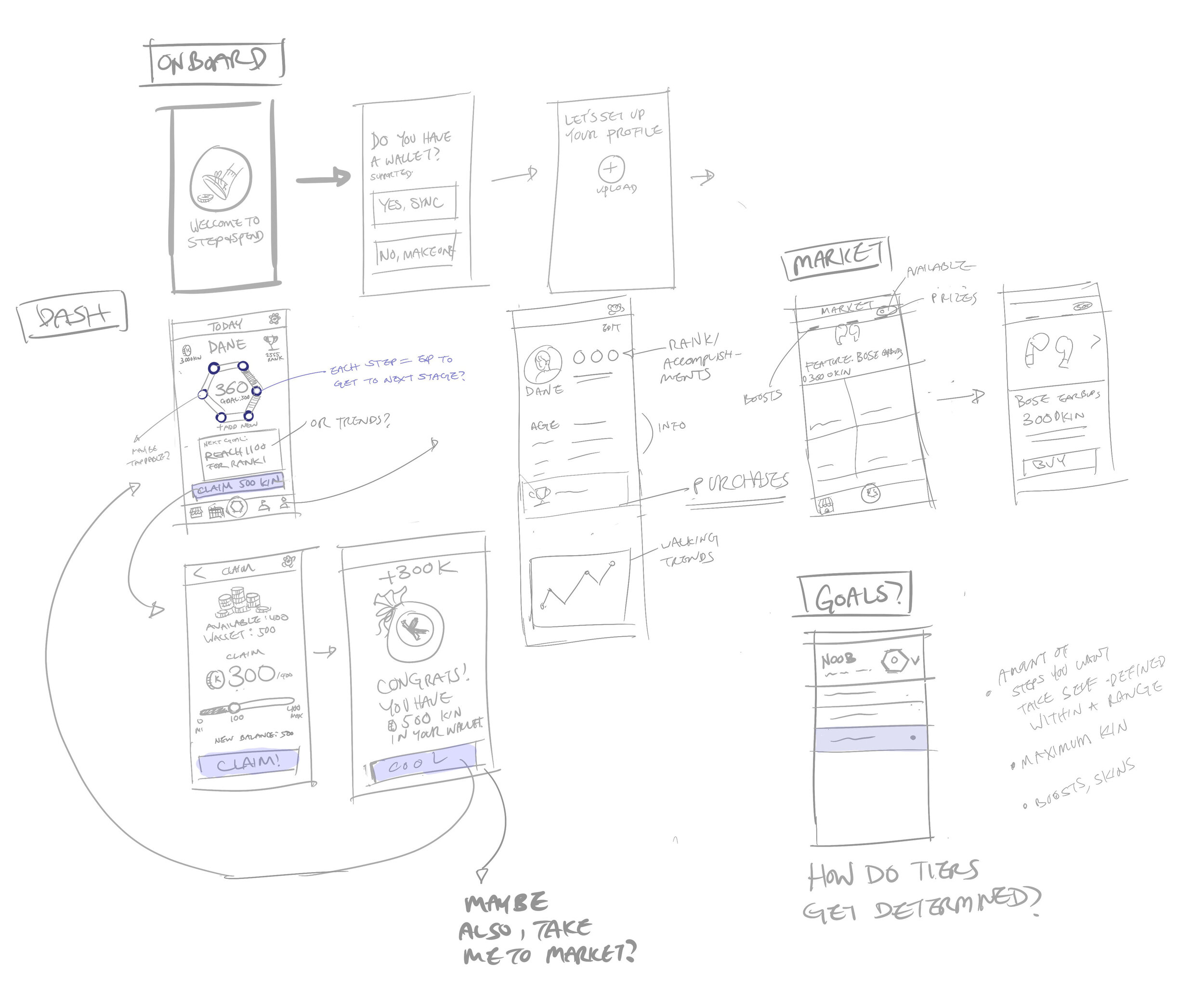
Step Gauge
The main interaction of the app is to keep track of step counts to receive Kin. To prevent users from setting a low goal on purpose to get Kin, we made the Kin claimable proportionate to the step goal— the higher step goal user has, the more Kin they can claim for the day.
I iterated on several designs that displayed the step amount. From these wireframes, emerged ideas of the ‘step gauge’, which would visually give a sense of fulfillment to the users.
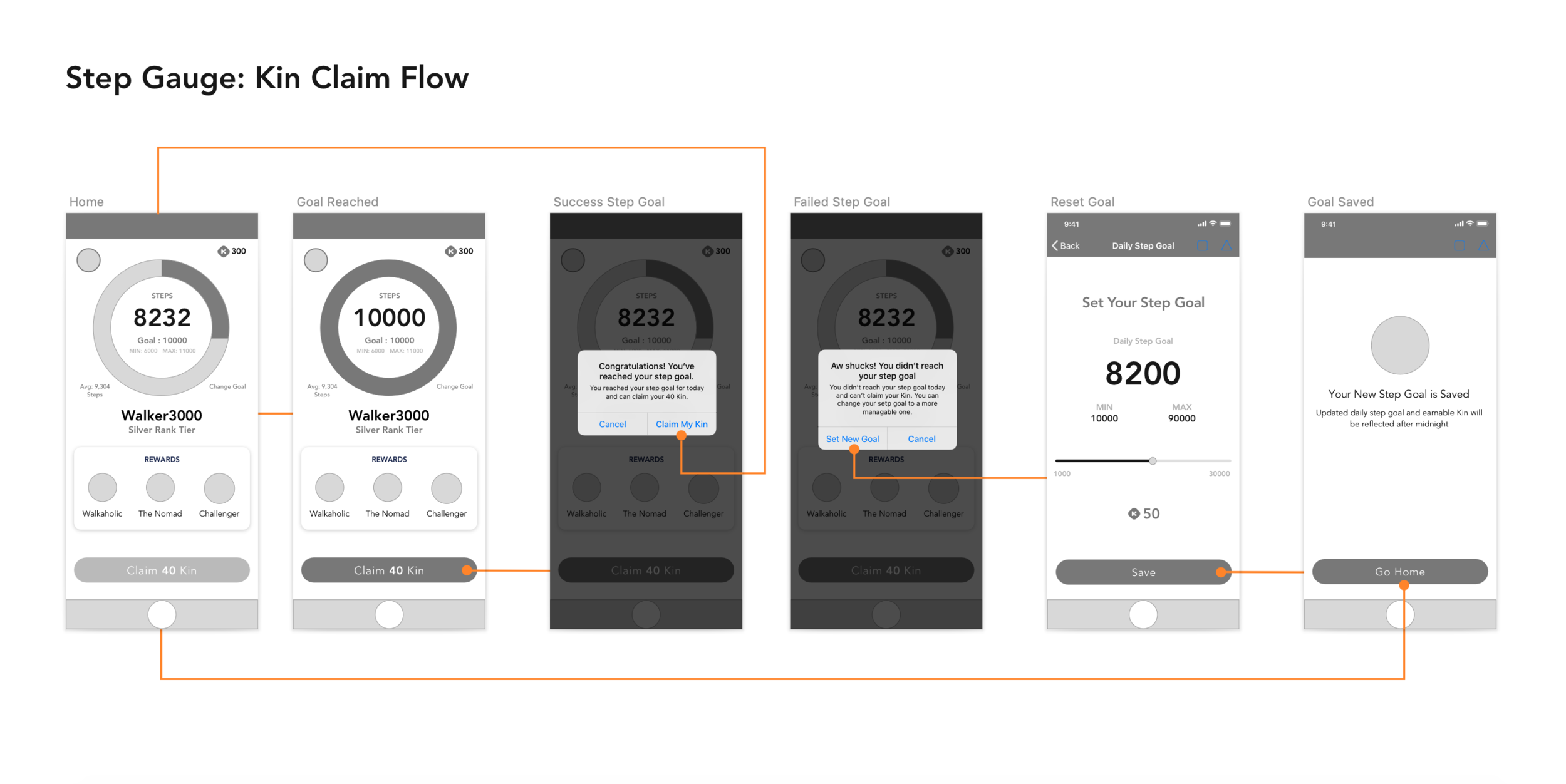
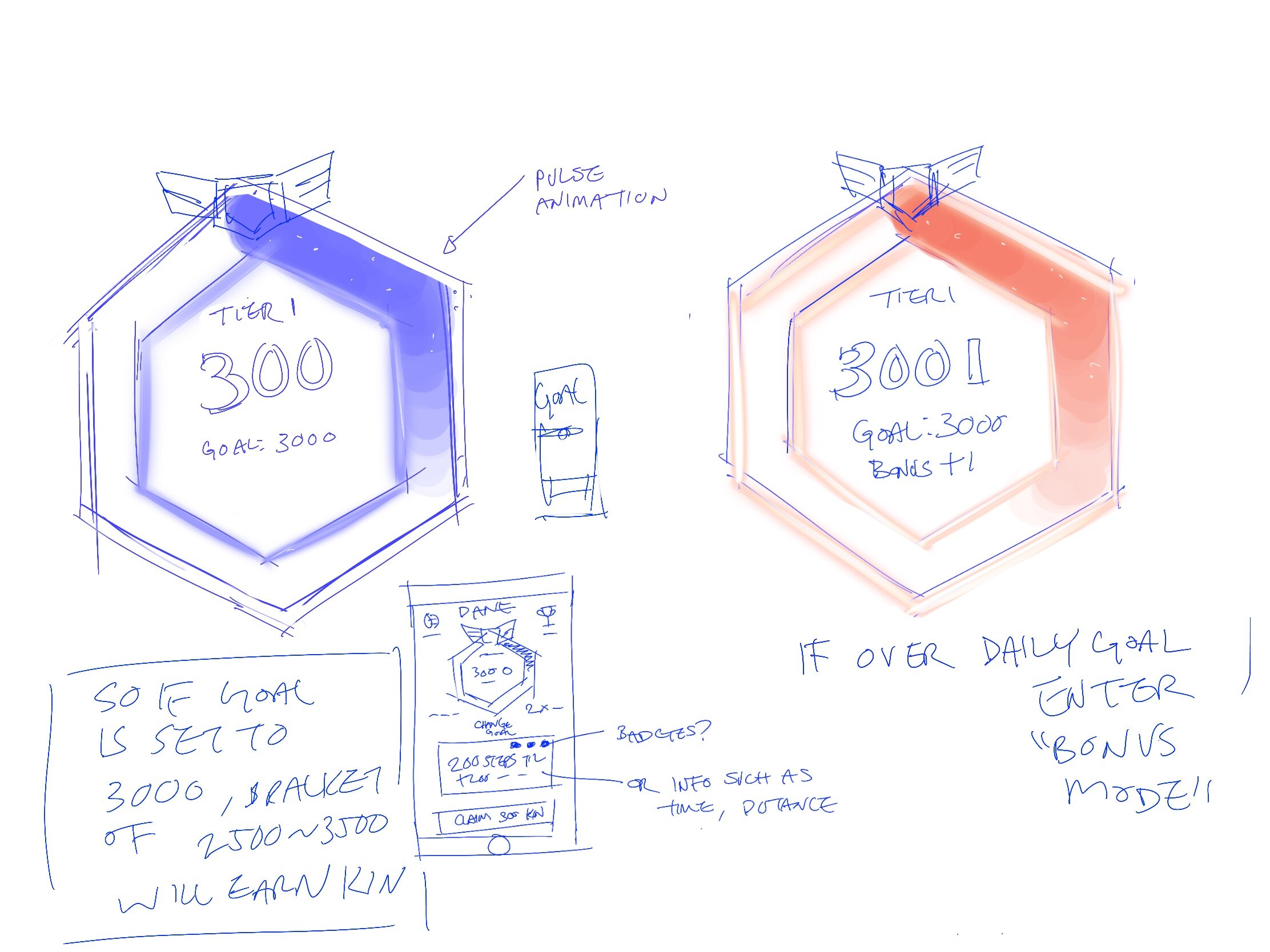
Onboarding
The simple user flow revealed that there needs to be an onboarding process where user first sets up their daily step goal. Since we wanted there to be a peer-to-peer connection for the sense of community, we decided that each user should have a profile, conveniently linked to their Google account.
During the profile design, I referenced some other pedometers, thinking about other metrics users might want to keep track of their steps, such as walk time and distance. We were able to implement these metrics through HealthKit and GoogleFit API.
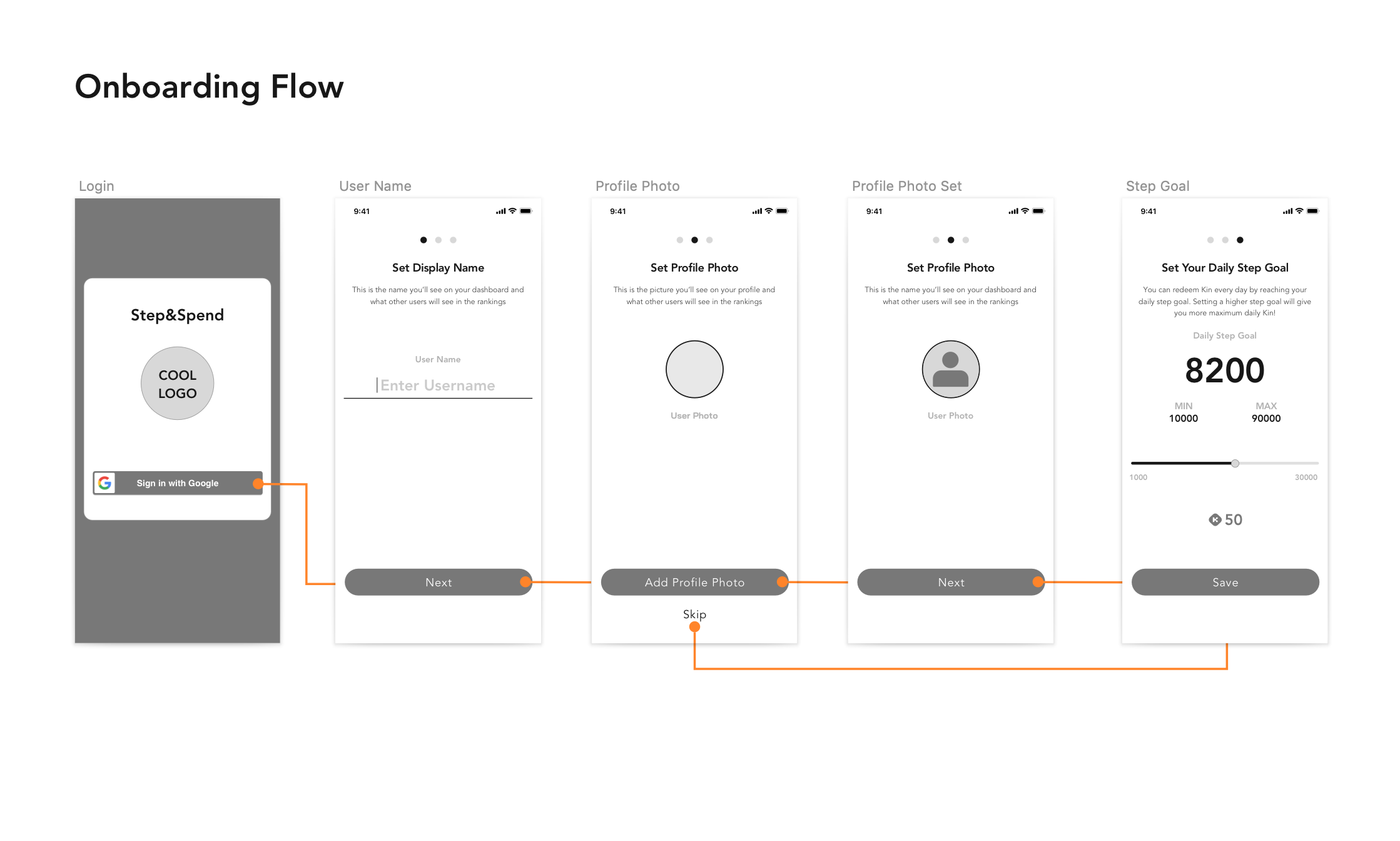
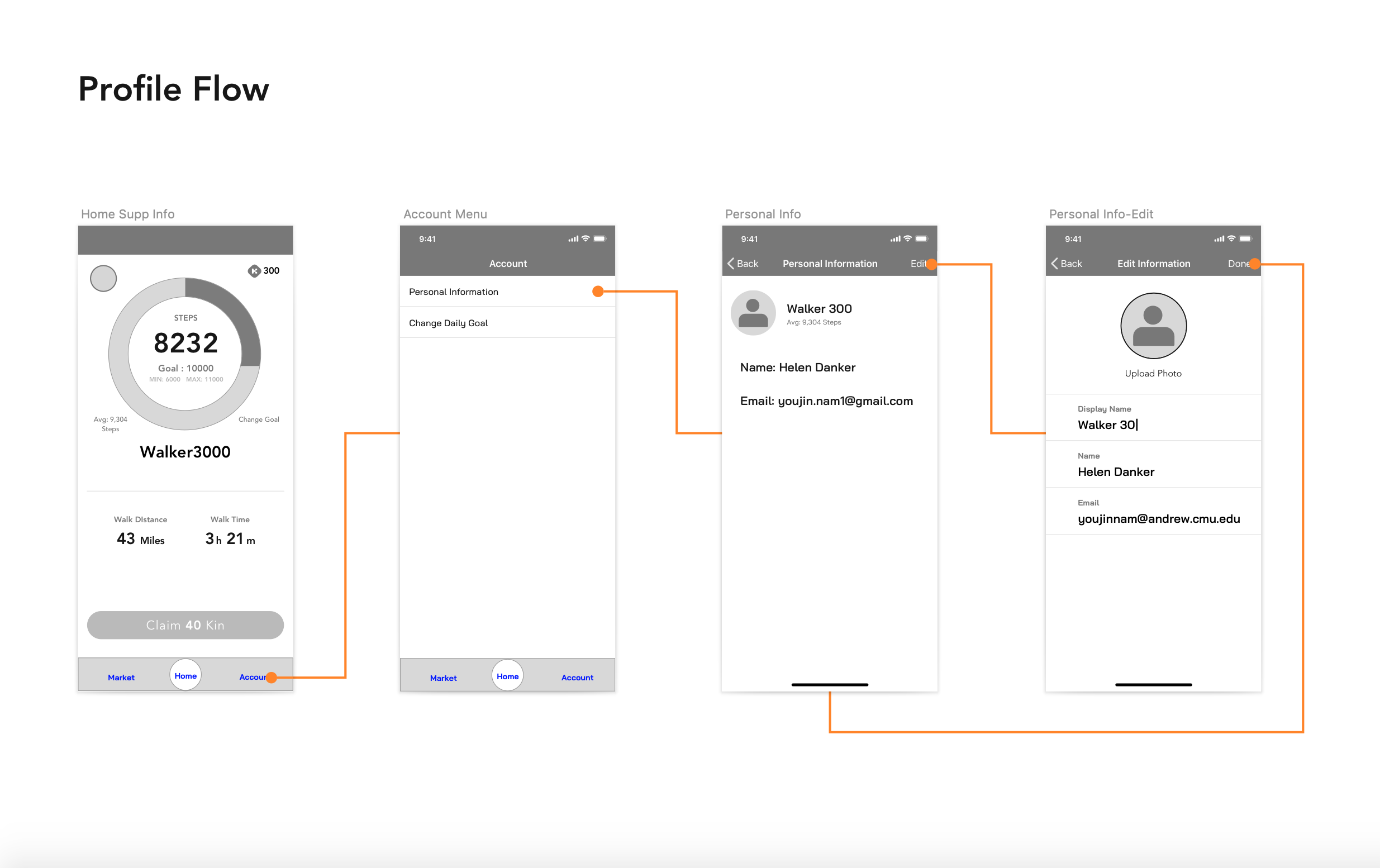
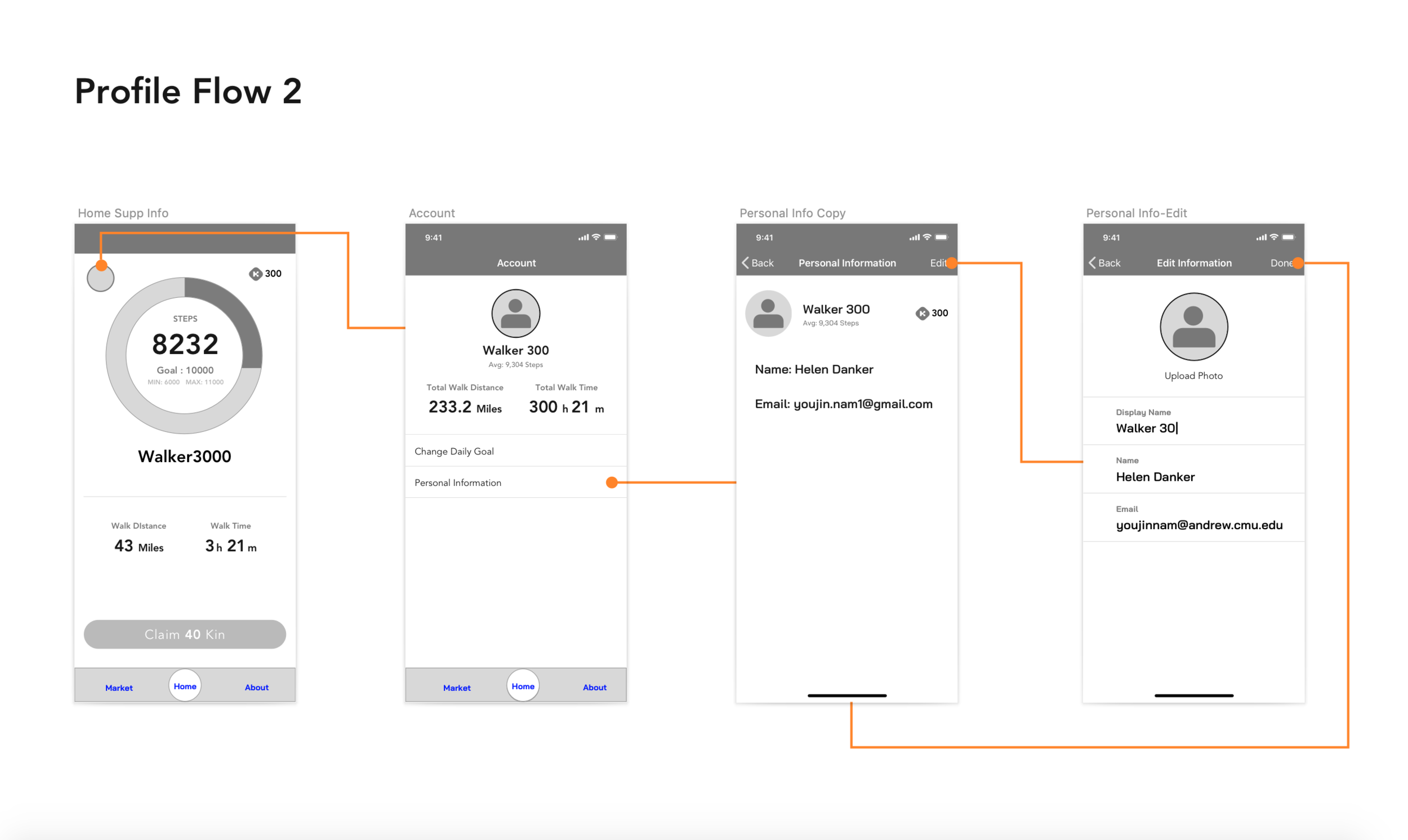
One of the issues with profiles was that we wanted to protect user information as much as possible, as privacy was one of the biggest concerns. I leaned away from storing any biometric data such as weight and age to keep the app as lightweight as possible for the users.
Marketplace
One of the problems identified from the user flow was that there was no circulation of Kin, meaning, no output for Kin to be used within the app. The flow ends when the user earns their Kin, and a novice user may not understand or find the value of it, especially because a few piece of Kin would not translate to sizable amount of money. Together with my team, we pitched some ideas that may be an appealing in-app use.
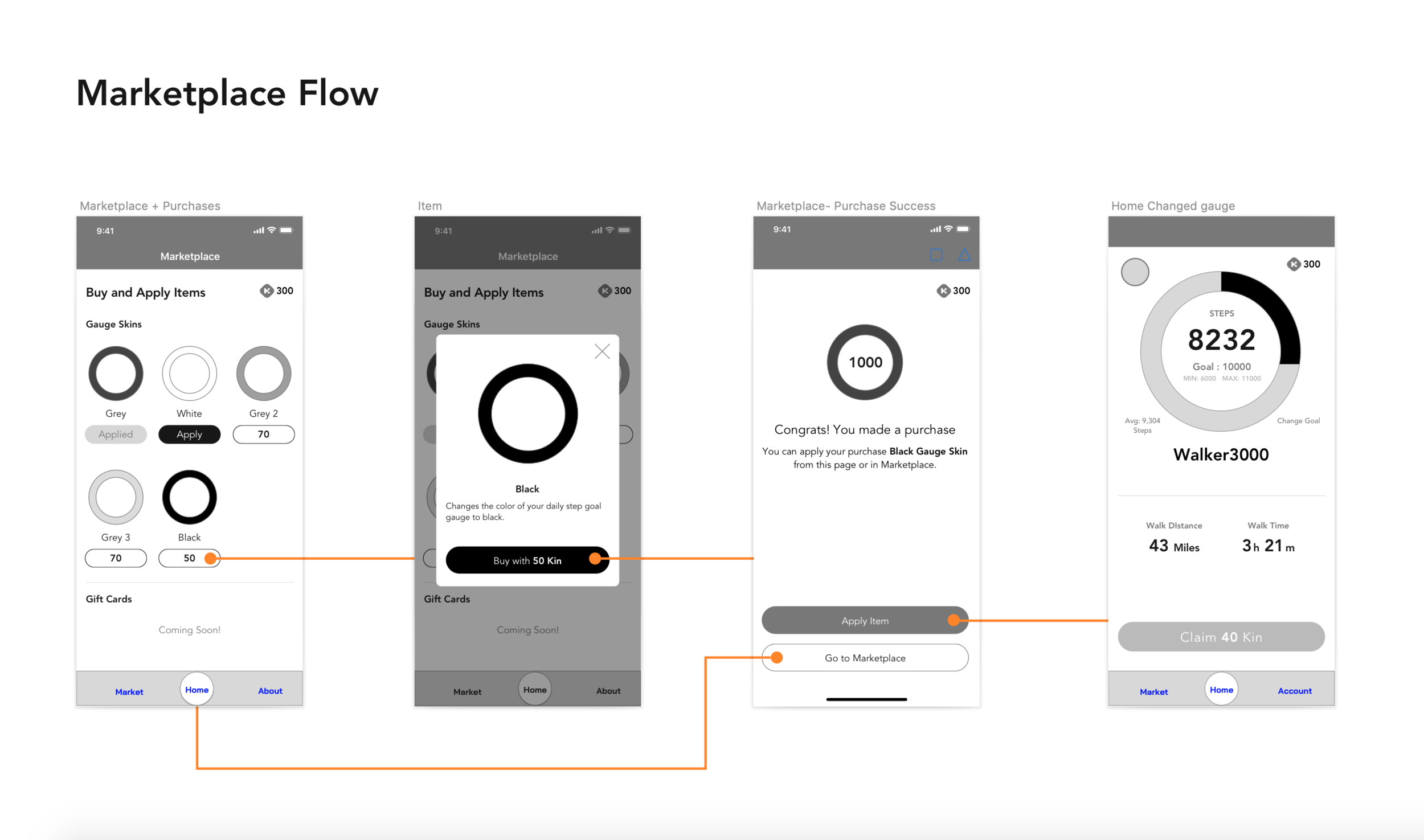
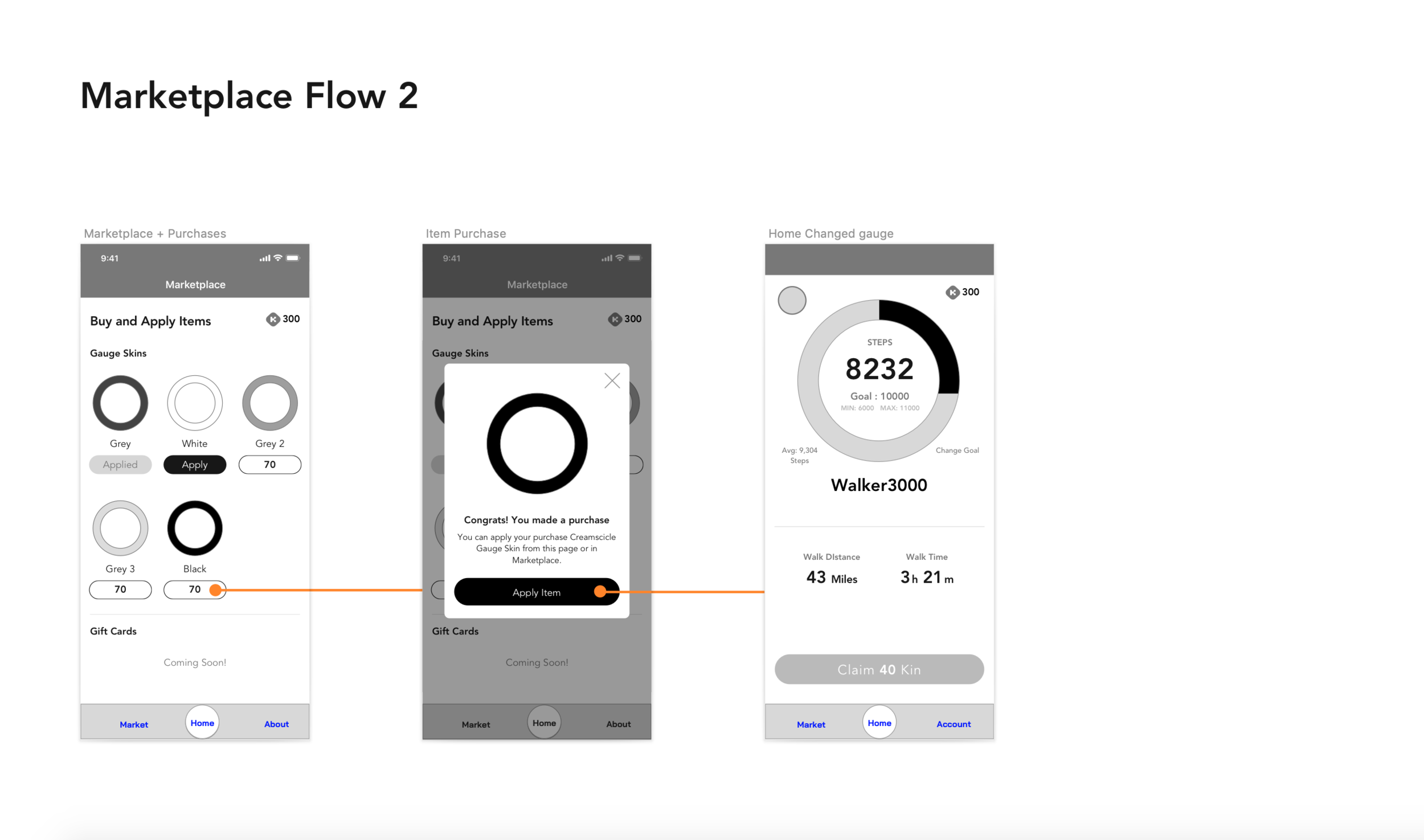
Because the most prominent factor in the app is the big gauge in the app home, we decided to utilize it as a way for customization by letting users purchase gauge ‘skins’ to change its appearance.
Leader Board
Building in the profiles and username functionality allowed for users to have an alias. We used this to build in a peer-to-peer connection through leader board. Leader board would surface users who had the highest step count for the day and also let other users reward them with Kin. This not only encourages users to set a higher step goal, but also to engage with the app more often.


Final User Flow
In the end, our user flow looked more flushed out, with clear organization of features and user goal.
User Interface & Visual Direction
For our visual direction, I wanted to lean back into the gamification idea. I realized from our competitive analysis that, while a lot of the crypto apps in the wild are wrapped in fun colors and game-like interface, it was actually quite hard to navigate around due to the convoluted interactions and no hierarchy.
Our focus was to make our app seem fun and modern. I designed branded icons and assets that reminded me of mobile games. Using Lottie, I was able to support devs with transition animations and loading screens from After Effects. I also created a design system for components and set them up in Zeplin for developers, which helped to have consistent visual language throughout the app.
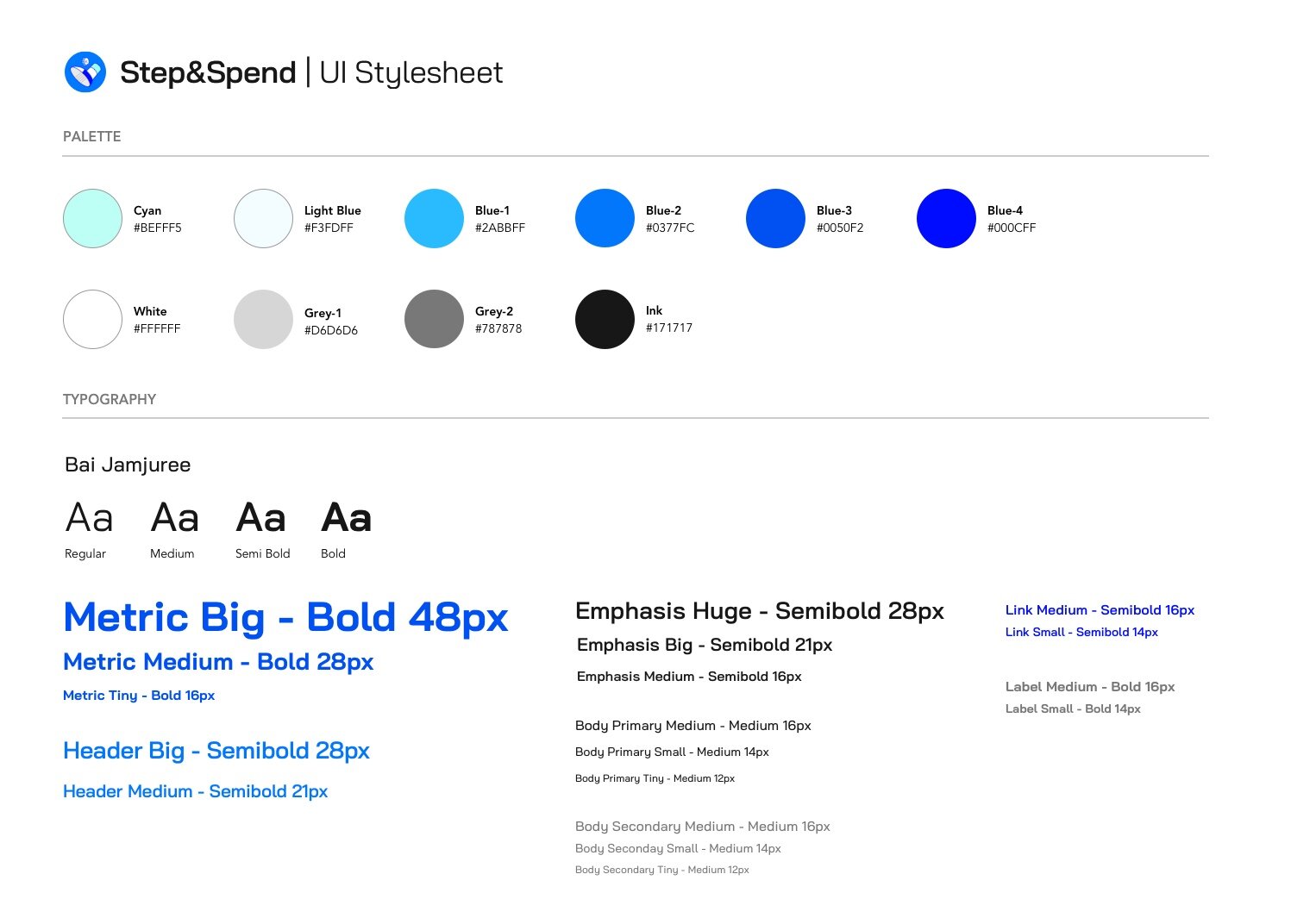
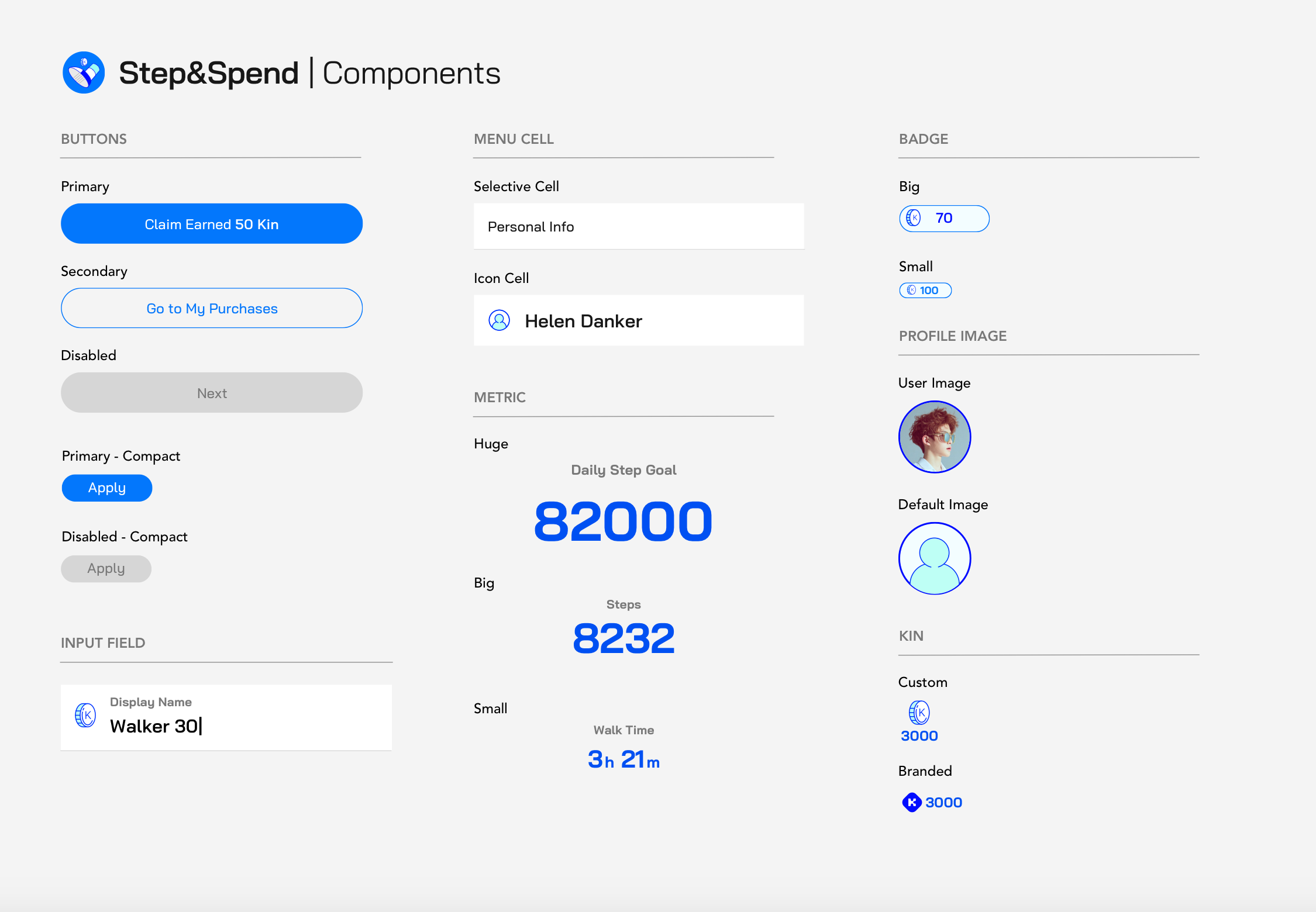
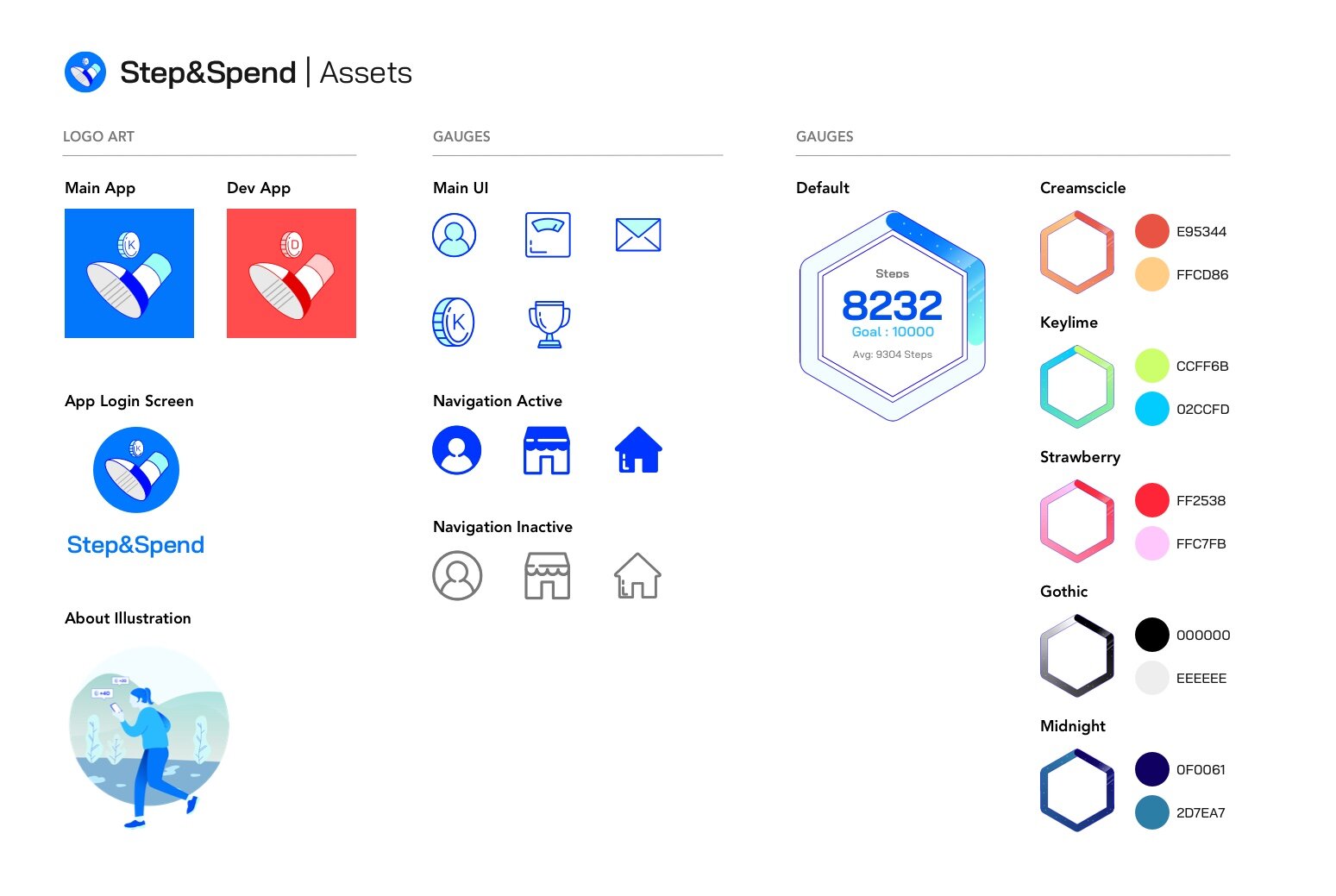
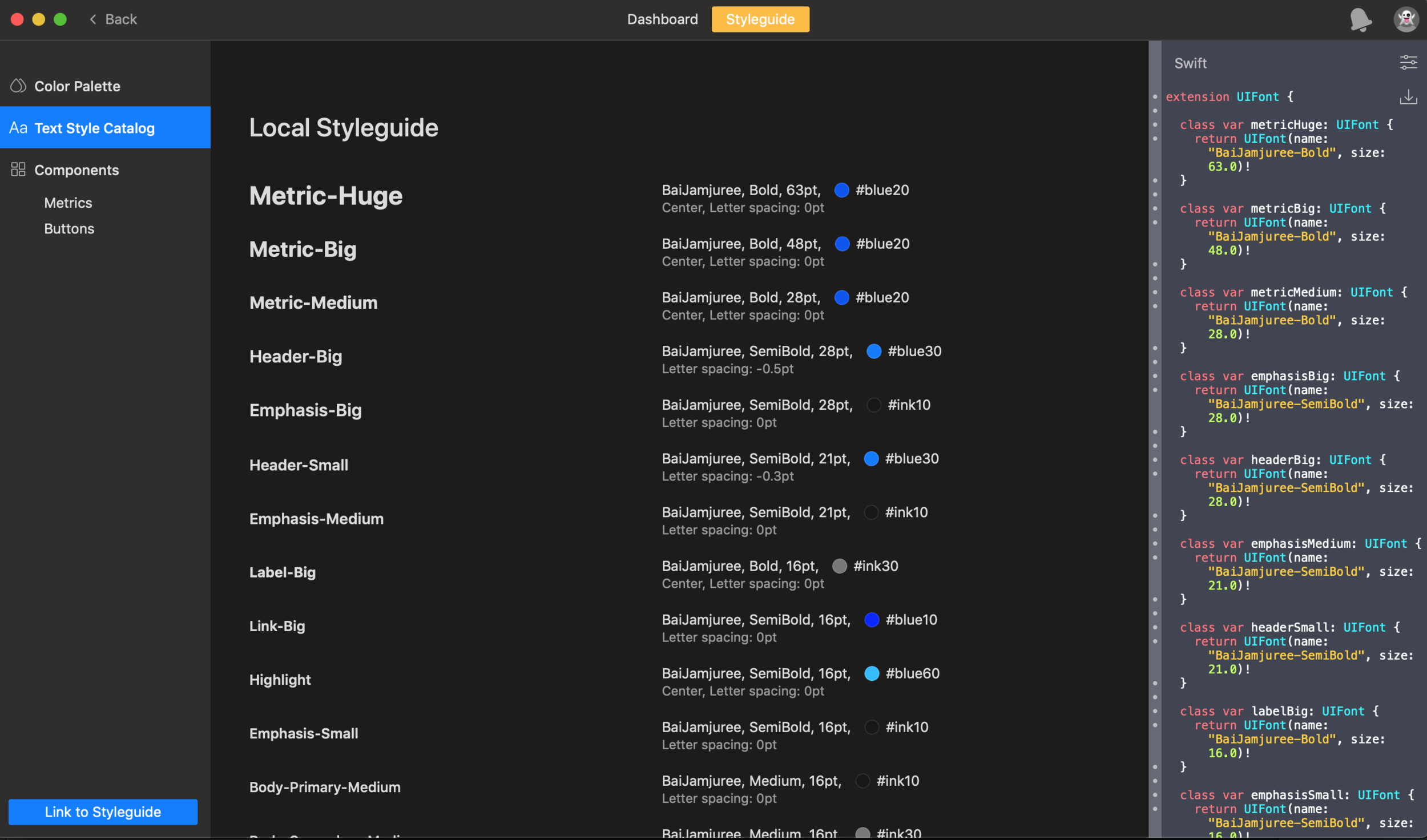
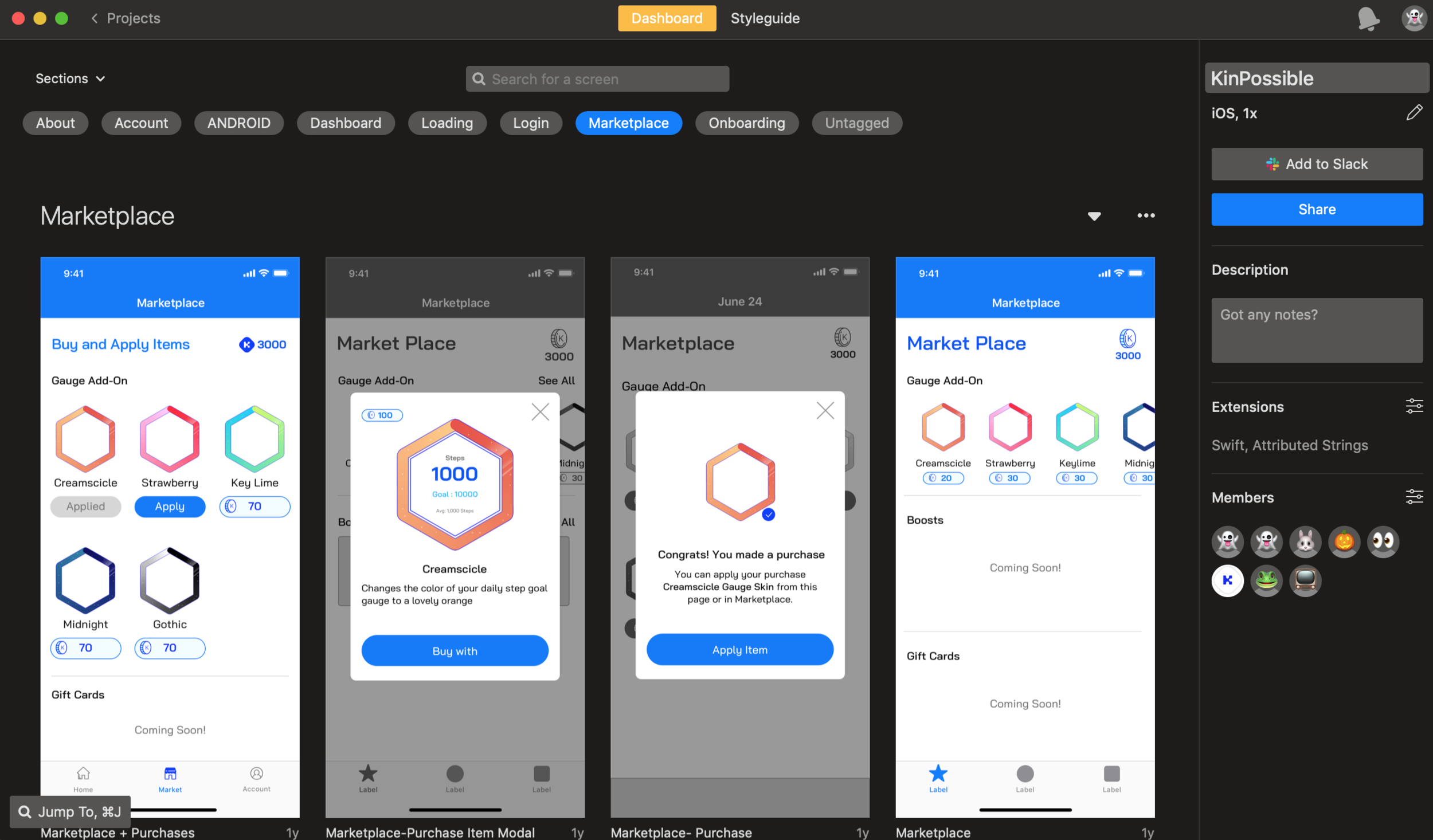
Usability Testing
Prototype Testing
At this point, we had already built a working prototype of our app through rigorous dev work. We identified 5 users around the office who we identified as ‘novices’ and gave them access to the beta app.
At the beginning of the day, we watched the participants onboard and set their step goal, then asked them to connect back with us at the end of the day once they had reached their step goals. Then, we watched them perform the rest of the tasks such as claiming their Kin and using the marketplace and leader board.
Our notes and participant feedback during this session revealed several aspects of the design that worked well but also places we could make improvements on. I organized the common patterns from each task which we could incorporate into our designs.
Reflections
In two short months, my team and I were able to conceptualize, develop, test, and release an app in both iOS and Android platform that could help novice users engage with Kin cryptocurrency effortlessly and daily. In the past years, cryptocurrency has been a rapidly growing field that bridges technology and finance. Like any new technology, it is essential that newcomers feel welcomed through low barrier of entry and low risk in order for cryptocurrency to continue its growth.
If we were given more time, I would have wanted to explore the community and incentive portion of the app more. In addition, we could have explored the notifications more, reminding users to get back into the app to claim Kin or to encourage them when they’re close to the step goal.
Step&Spend currently has 100+ downloads and is one of the only apps to sync cryptocurrency with healthy habits. We were also able to claim the earlybird prize for the Kin competition. Working as the sole design lead for this project, I was able to learn how to project manage and self-direct an end-to-end design process. This project also gave me an insight into the app development and release, including the legal and technical complications of the process. Ultimately, it challenged and improved my skills as a well-rounded designer.





